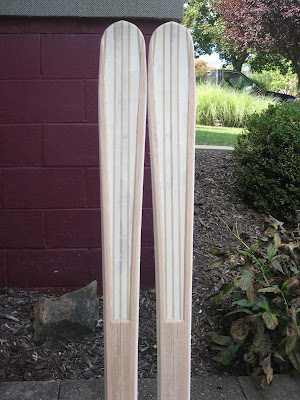The rails are made from oak to provide maximum stiffness to the core while minimizing the required height. The rails were trimmed to 5mm thick and 18mm wide. In order to attach the rails to the core, the outer edge was beveled to 30 degrees from vertical to match the sidewall profile and the inner edge was beveled to 45 degrees. 45 degrees on the inner edge provides a more gradual slope that the top sheet should contour to easier when attached. The beveling was done using a table saw.
Next, the ends near the tip and tail had to be tapered. In order to do this I set the table saw to 3mm and then 1mm and cut the rails down. This preliminary cut stepped the ends so that less sanding was needed. The steps were then sanded to provide a smooth taper.
Once the rails were cut to size, they were sanded with a belt sander.
Next, the rails were glued to the core; the rails were bent to match the edge curvature of the ski and clamped in place. The ends of the rails extend past the ends of the ski and will be trimmed of when the glue is dry.
Next a binding platform had to be added to provide a level surface to mount the bindings. This was done by cutting several strips of oak and then beveling the edges to fit together.
Once the sides were beveled, a bevel was added to the ends of the binding platform to provide a smooth transition to the top of the core.
The binding platform was then glued and clamped in place.
Once this was complete, the ends of the rails were trimmed with a jigsaw to match the tip curvature. The rails were then sanded to provide a smooth transition on the sidewall. The top edges of the rails were rounded so that the top sheet would more easily fold over the sides.
The skis are nearly finished now; the final step is to design the graphics and press the fiberglass, graphics, and top sheet onto the ski. Once done, the bindings will be mounted and the skis will be grounded, waxed, and sharpened.







































